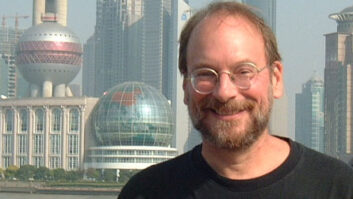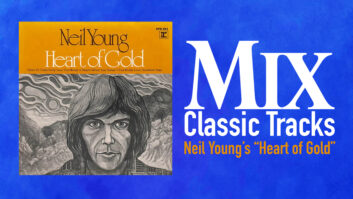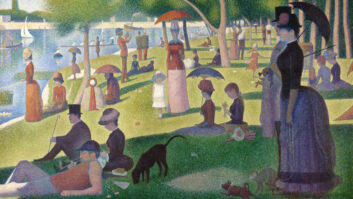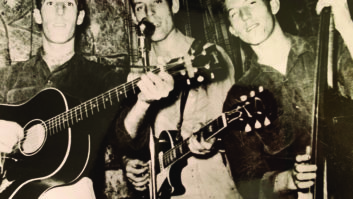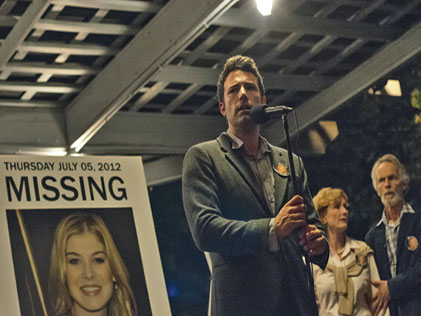
Nick and Amy Dunne, attractive New Yorkers who have moved to heartland Missouri, certainly don’t have a perfect marriage. But is that any reason to suspect that Nick (played by Ben Affleck) might be involved in the disappearance of his wife (Rosamund Pike)? Director David Fincher’s latest hit film, Gone Girl, is a taut thriller that masterfully doles out clues to the central mystery, as it also explores the complicated dynamics of the couple’s troubled pairing, and how their friends, relatives, community and the media respond to Amy’s vanishing.
Fincher’s films always have interesting soundtracks, and Gone Girl’s is one of his most effective and engrossing. Indeed, the sound design and music are vital components of the storytelling and aids in ratcheting up the tension. Since his first major feature, 1995’s Se7en, Fincher has worked closely with Bay Area-based sound designer Ren Klyce, and posted his films at Skywalker Sound in Marin County (Fincher’s home turf). Among those working with Klyce on Gone Girl were stalwarts such as re-recording mixers Michael Semanick (FX) and David Parker (dialog), dialog supervisor Rich Quinn, ADR editor Gwen Whittle and Foley editor Thom Brennan. FX editors included Malcolm Fife, David Hughes and Al Nelson.
For Fincher’s last three films—The Social Network (2010), The Girl with the Dragon Tattoo (2011) and Gone Girl—the team of Trent Reznor and Atticus Ross supplied the always-intriguing original music. That duo won an Oscar for The Social Network (as did long-time Fincher film editor Kirk Baxter, who also has great input on the soundtrack); Klyce, Parker and Semanick earned sound nominations for that and Dragon Tattoo. So they’re on a roll.
Between the sound design and the music, it’s an incredibly full soundtrack. What might seem on the surface to be conventional narrative scenes are actually deftly woven sound-and-music constructions, where, say, cicadas and crickets provide a steady drone and contribute to the feeling of unease unfolding in the story, or the tone of the background walla shifts subtly over the course of various crowd scenes, as new facts come to light and affect people’s view of Nick. Each locale and every scene in the film has its own sonic personality, even when it is an uneasy silence.
“We’re always looking for a certain realistic density,” Fincher says. “There’s a lot of sound in the world. But with the sound and the music—and there’s more music in this movie than in a lot of the ones Ren and I have done—we were looking for feeling and also for understanding where we were in the world: We’ve moved back in time, we’re in New York City, or now we’re in Missouri. So, I don’t think we were trying to overload people’s ears as much as there was a lot of music and we still needed to have the vertical story of where you are in the narrative.

David Fincher and his crew. Photo: Merrick Morton.
“The great news about Ren, the great news about Kirk, the great news about Trent and Atticus, is you’re never talking to them about technique or technical things; you’re talking about feeling. What’s the feeling that we want here? Are we in anticipation of something here? What should it feel like when the other shoe drops? One of our biggest considerations throughout was, at what points are we going to be mundane and literal, and at what points are we going to allow things to be stylized to make a point?”
“Fincher really wanted to have backgrounds kind of on the edge, like we did at the beginning of The Social Network, where he wanted to challenge the audience,” Klyce says. “David wanted a do a similar thing here with the opening sequence, where Nick and Amy meet at the party [in New York]. We initially had a mix where it was just dialog and music, and it was this notion that they were falling in love and romantic, and the people in the background weren’t even audible. But David came onto the stage and said, ‘No, no, I don’t want it to be that kind of movie! I want it to be like we’re in New York, we’re at a party and there’s a hundred people in the room they want to escape.’ He was constantly pushing us to amp up the sound effects and he really wanted to feel that texture throughout.
“He also wanted to create a difference in texture from the early happy days in New York to the temperate cicada-filled, cricket-laden Missouri bad days in the relationship between the two characters. When David was filming [in Missouri], he phoned and said, ‘This place is just filled with cicadas; we’re going to need a lot of cicadas.’ And on the production dialog itself [from the Missouri exteriors] you would also often hear crickets. For example, at the candlelight vigil, where Nick is making his plea to the townsfolk [to help find Amy], that production dialog had a lot of cicadas and evening crickets, so that tipped us off to create this texture for those scenes. From there we started to explore the little micro locations in the town—for example, when we go to Nick’s father’s house, it’s down by the river and you can see the bridge in the background. David wanted different frogs and textures there, so we would always have a similar feeling when we’d go back and forth from location to location; to give a sense of familiarity to the locations.”
Klyce’s sound editors/recordists certainly had their work cut out for them gathering material for the wide variety of ambiences the film required—some prominent, many subtle. For instance, Klyce notes, “When Amy goes off to the Ozarks, we really wanted to have some rural, hillbilly-like background sound, but I didn’t know what that would be, outside of recreational sports, so one idea I had was, what if we always heard young people screaming and riding their motocross motorbikes in the distance?
“We had a really good group of people collecting sounds all over the place. Al Nelson recorded a lot of the cicadas and the motorbikes in South Carolina, the Florida Everglades, Mississippi and Louisiana. We also had Josh Gold in Missouri, recording ambiences. Josh also recorded in various venues, like bars and restaurants, to get the appropriate accents. We wanted to hear walla without it sounding scripted for loop group.”
Klyce says that Fincher is “very attuned to the minute details of things—the photography, the props, the lighting, his picture editing, the sound. Everything in his photography is moving constantly and so is everything in his sounds. So he always wants to have these very complicated setups for something as simple as, say, two people talking in a restaurant. A scene that a lot of people would classify as a ‘normal’ scene, he makes very complicated, because he wants to do something interesting with it.”
Parallel to the mystery story in Gone Girl is a strong thread about how media affect the stories they cover and how at the same time the players in those stories try to shape/manipulate the narrative to their own ends. Here, for instance, the initially sympathetic press turns on Nick with an almost frightening fervor.
“I wanted the sound in those scenes to reflect a very specific escalation,” Fincher says. “The first time, they’re very polite to Nick—‘Can you please smile? Can I have you stand next to her [mother]?’ Then the next time it’s a little more rabid. And then, by the time he’s coming out the door with Tanner [Nick’s lawyer], they’re practically a lynch mob. We wanted this escalating [sonic] personality, where you felt the evolution of their disdain.”
Klyce adds, “David got very excited about the idea of creating another character, in a sense, from just the noise of the paparazzi [in post]. He got so into it he said, ‘We need to write lines for these people, and really give them a sense of the lines of questioning.’ So we wrote our own ‘bad version’ of lines they might say, and I sent them to David and he got the writer, Gillian Flynn, involved. He sent our ‘bad’ version to her and then she wrote a whole bunch of different phrases we could give to our reporter [loop] groups.
“The other thing David demanded from the reporter voices in ADR is he didn’t want them to be recorded indoors, which is typically what we do with all ADR. You go to Tom O’Connell’s stage or Doc Kane’s stage, and it’s a perfectly padded room with certain acoustics. But David really wanted to go outside to record, which is difficult to do because you can’t control the outdoors. So I had to go through all these tests with him where Steve Orlando—our sound effects assistant—and I would set up various microphones and we’d go out to all these locations and do tests reading the script that Gillian had given us. I’d send audio tests to Fincher: ‘What do you think of this location?’ ‘No, it’s two echo-y; I can hear it bouncing it off the back of a building. I don’t want to hear any reflection. I want it to sound like it’s in an open field.’ So we tried the baseball field up at Skywalker and ended up setting up just behind second base, and I think we had six microphones with two different synchronized recorders and did a bunch of tests out there. Fincher picked setup number two, I think it was,” he laughs. “But that’s how detailed he is.”
“Then we got the [voice] actors to come out on the field, and Skywalker shut down all the outdoor activity on the property while we recorded. We also did it from various distances, because when people are close to a microphone and yelling, it’s a much different sound than people far away from a microphone yelling. We did a lot of experimentation and a lot of takes of people outside yelling, and then also ones of people running toward the microphone and running away from the microphone.” Recording was to Sound Devices 744s with a variety of mics, including Sennheiser MKH 416s and Neumann KMR 81s.
“There’s also a scene where Nick gets out of prison and gets into a limousine and people are banging on the windows and yelling, so we got all the actors to surround our cars and had them scream into the car,” Klyce says.
The Reznor-Ross score is probably not one most people would expect from a suspense film (nor from the frontman of Nine Inch Nails). In many scenes it sort of drifts and floats in the air like a soothing balm, a counterpoint to what’s actually happening in the story or in the characters’ heads. It’s quite a striking juxtaposition. “We showed Trent the movie and started talking about how it should envelop the audience,” Fincher comments. “I had just had a back adjustment [with a chiropractor] and I was talking with Trent about that music that’s designed to kind of lull you into a sense that it’s good for you, it’s healthy and it’s all okay. And I liked that it had this sort of looping, drone quality. I told this to a laughing Trent Reznor, who said, ‘It just so happens I picked up a pan flute,’ so he took that little tidbit and ran with it, and this is what he came up with.”

Photo: Merrick Morton.
Klyce says that Fincher’s term for what he was looking for was “spa” music. Much of their score is edgier than that implies, but it does have some of that vibe, for sure. “The way David envisioned it,” Klyce says, “is that the whole relationship between these two characters is sort of a ruse. They’re both pretending to be something they’re not and they’re kind of creating their own background. So the notion of, ‘Ah, everything is great’; this feeling of being on anti-depressants, would somehow create a sense of tension by the fact that it’s so calming. I think that was a really great idea on his part. You can definitely create tension with dark music, of course, but by creating it with this happy sound is almost more eerie in a way. So Atticus and Trent started to write and they’d name [the cues] after drugs—Klonopin, Xanax; many of their music cues had different anti-depressant titles. It really created a great background for the couple living this ‘perfect’ life in this ‘perfect’ house, where everything is not perfect.”
On Gone Girl, as on the other two films they scored for Fincher, Reznor and Ross began fashioning rough versions of cues while shooting was still going on, basing their work on descriptions of scenes, inspiration from the script or early cuts by Kirk Baxter. Baxter, music editor Jonathan Stevens and Klyce then would each do a pass cutting down longer pieces of music into something more manageable for the specifics of a given scene as it took shape. “We started very loose,” Fincher comments, “kind of saying ‘Give us some stuff and let us lay it up against picture, and then you respond, and then we’ll respond, and keep refining it.’” Or as Klyce puts it, “[Trent and Atticus] would give us MP3s and we’d do the rough ‘caveman’ version of it, and we’d turn that back to them and they’d say, ‘Oh, we see what you’re doing here,’ and they’d take the ball back and finesse it to picture.”
Not surprisingly, the final mix, at Skywalker on a Neve DFC, was a complicated affair, but made considerably easier by the smooth working relationship of the mixers, editors and their demanding—but trusting—director. “It was really tricky,” Klyce concedes. “There’s so much clever writing in the screenplay, and David’s style on set with his actors is he gets them to be very natural, so they’re often not projecting a lot and some of the lines are delivered under breath, softly. So to get the dialog to ‘speak’ [in the mix], and weave that in and out of the voiceover, wasn’t easy. But David Parker, who premixed and mixed the dialog, and who’s been on all the Fincher films and is sort of our mentor on the mix stage, did a fantastic job. Having Michael Semanick mixing FX and me mixing music creates a good sense of checks and balances. By holding the music faders, I can tune into what Trent and Atticus’ work is doing, and it gives us a sense of perspective as to how best to suit the soundtrack.
“Parker, Semanick and I will mix and work a scene together. If there’s a music cue, we’ll go round and round and cycle through the entire cue. I’ll be mixing and panning the different tracks the composers have given us, but Parker, Semanick and I are all mixing simultaneously—dodging and burning moments and lines, and tucking FX and doing these minutiae moves. One of the fun things about working with Semanick after all this time is we’ve really learned how to balance one another. Sometimes he’ll introduce the music by pulling the sound effects out, or vice versa. We’ll cross between the sound design and the music: ‘I’ll hand it off to you here and you can give it back to me there.’ We go through and figure out the architecture, then we’ll work on the execution. Then Fincher will ultimately come in and say, ‘No, the music is coming in too loudly; have it come in more softly.’ We’ll fine-tune a sequence or scene, focusing on the emotional impact that Fincher wants to express.”
